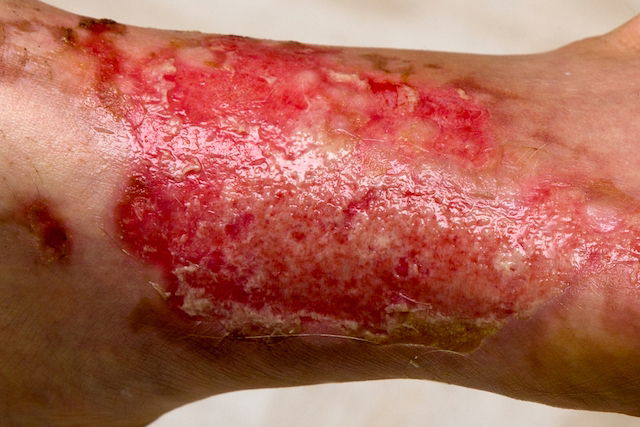Scalded skin syndrome is typically the result of an infection in another part of the body, and is caused by some species of Staphylococcus bacteria. This bacterium releases a toxic substance, which is transported through the blood to the skin and causes symptoms such as scaling, redness and formation. blisters, leaving the skin looking burned.
This disease is more common in newborns, babies or children under 6 years of age, and may arise due to staphylococcal infections in the umbilical stump, upper respiratory tract, ear or eyes, for example. Although it is rare, it can affect older children or adults, especially if they have a history of a weakened immune system or serious kidney disease.
Treatment for staphylococcal scalded skin syndrome, also known as Ritter's disease, is carried out by a dermatologist, pediatrician or general practitioner. It usually involves hospitalization, with the use of antibiotics and moisturizing creams that promote skin healing.

Main symptoms
The main symptoms of scalded skin syndrome are:
- Skin irritation
- Fever or chills
- General malaise
- Blisters on the skin, which may appear within 24 to 48 hours after exposing the skin to toxins
- Blisters containing clear fluid or pus
- Intense pain when touched
- Intense redness
- Crusting around the lesions
- Soft, wrinkled skin at the site of the injury
- Peeling of the skin
- Cracks in the skin
When this condition is progressing, the top layer of the skin begins to come off in pieces, which makes the skin look burnt. Blisters that break easily also start to the develop, as well as other symptoms, such as irritability, loss of appetite, conjunctivitis or even dehydration.
In babies, the symptoms of this syndrome mainly appear in the diaper area or around the rest of the umbilical stump, while children may experience it on the face. Adults can experience this condition on other parts of the body.
Over time, if the infection is left untreated, the toxin continues to spread throughout the body, and can start to affect other parts of the body. It can become more visible in places of friction such as the buttocks, skin folds, hands or feet and can lead to a generalized infection.
Confirming a diagnosis
A diagnosis for scalded skin syndrome is confirmed by a dermatologist, pediatrician or general practitioner, through a physical assessment of the skin,- The doctor will also evaluate the patient's health history and if they had any recent staphylococcal infections in the umbilical stump, upper respiratory tract, ear or eyes.
In addition, the doctor may request a skin biopsy, which is done by collecting a small piece of skin tissue for analysis under a microscope to look for changes consistent with scalded skin syndrome. This lab analysis can also help to rule out other diseases with similar symptoms, such as toxic epidermal necrolysis, epidermolysis bullosa or bullous impetigo.
Other tests that the doctor may order include a complete blood count and urine tests (to determine whether a generalized infection is present), electrolyte levels in the blood (if dehydration is suspected), or culture tests from the site of the primary infection or the blister fluid (to confirm the presence of Staphylococcus bacteria).
Possible causes
Scalded skin syndrome is caused by toxins produced by some subspecies of Staphylococcus bacteria. They first appear due to infections in other parts of the body, such as the upper respiratory tract, eyes, ears or umbilical stump.
These toxins can be transported through the bloodstream and reach the skin, where they break down a protein, desmoglein 1, which is responsible for keeping the cells of the epidermis together. This destruction causes the skin to lose its ability to maintain its structure, and leads to symptoms that can be localized or affect the entire body.
The main factor that can increase the risk of developing scalded skin syndrome in newborns or babies is the immaturity of the immune system to fight infections.
Older children or adults are at an increased risk for developing the syndrome if they have a history of a weakened immune system (due to HIV infection, for example), chronic kidney disease or kidney failure.
Treatment options
Treatment of scalded skin syndrome should be guided by a dermatologist, pediatrician or general practitioner. It typically requires hospitalization IV antibiotics that later progress to oral antibiotics. Patients can also be given IV fluids to prevent dehydration.
During treatment, the doctor will advise moisturizing creams and non-adherent dressings on the skin to promote healing, reduce heat loss and protect the new skin that forms. The superficial layer of the skin can be quickly renewed, healing in about 2 weeks after starting treatment.
Newborns affected by this syndrome are normally kept in an incubator.
Possible complications
If scalded skin syndrome is not treated promptly, it can cause complications such as dehydration, an electrolyte imbalance in the body, secondary infections, kidney failure or generalized infection.






























